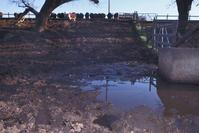

|

|
|
How to Manage PestsMosquitoes

Dairy wastes can breed hordes of mosquitoes. Dairies face wastewater management challenges on a large scale. A full description of dairy construction is beyond the scope of this publication, but the tips in this section can help minimize mosquito production. Drain the liquids from a dairy and store them properly or use them for irrigation. By law, dairy drainage must not percolate into groundwater or contaminate surface water. If you grow crops (including forage crops), an excellent method of eliminating a source of mosquitoes is to store the nutrient-rich liquid in a dairy lagoon for use in an irrigation system. Using liquid manure can yield great savings in fertilizer costs. Barns and pens should be surfaced with concrete and sloped to a drain at a slope of 2 to 3 percent (1/4 to 3/8 inch per foot, or 2 to 3 centimeters per meter). Pipe washwater and liquid manure to a separator and then a holding lagoon. Corrals and other earthen outdoor work areas should be graded at least 3 percent and configured according to an overall drainage plan for the facility. This avoids ponding of wastes and rainwater. Regrade as needed to eliminate ponding and muddy areas. Ideally, the corrals and milking parlor should be at the highest elevations and the lagoon at the lowest. You can also minimize disease risks if you provide good drainage and flushing and locate holding basins at low spots, away from animals. Liquid manure should first be run through a mechanical separator, a small separator pond, or other separation structure (apron, sump, or basin) to remove solids. Solids form floating mats that shelter mosquitoes and allow weed overgrowth. Excess fiber also blocks pipelines and can foul crop plants. Separated solids can be spread and dried to eliminate fly production. It is wise to have a backup system for mechanical separators, which occasionally break down. Separator ponds should be relatively narrow, no more than 60 feet (18 m) across. A narrow pond with a good road along it allows the application of mosquito control agents to the entire surface if necessary. Crusts of solids can cause problems if they form water-holding cracks where mosquitoes and flies breed in great numbers. Crusts can also prevent insecticides from killing mosquito larvae. Ponds can be agitated with water and pumped out if solids start crusting over. Compost removed solids or spread them thin to dry. Like all artificial ponds, the separator pond should be steep sided, and weeds should be controlled around its edges. Manage other separating structures so that no water stands for more than 4 days. Properly constructed dairy lagoons can minimize mosquito problems. Like separator ponds, lagoons should be steep sided and weeds should be controlled around the edges. Use an agitating pump or a solids filter to prevent the formation of loose surface crusts and algal mats. Depending on the landscape, wide lagoons, greater than 100 feet (30 m) in diameter, may be subject to wind action that provides some natural control of crusting. However, if this does not occur, use narrower lagoons so that insecticide sprays can reach the whole surface. The storage volume should be 15 cubic feet (0.42 cubic meter) per cow per nonirrigation day. This volume prevents overflow during the rainy season. Drawing off the water regularly for irrigations can help control mosquitoes, but it is essential not to overirrigate, which moves the mosquito problem into the fields. If possible, refill lagoons and keep them at a stable level after irrigations to minimize weed growth along edges. Lagoons should be kept shallow only close to the onset of the rainy season in order to prevent flooding. Finally, provide a good access road around the lagoon for maintenance, weed control, and for occasional mosquito larvicide applications, if necessary. Mosquito abatement personnel have the legal authority to inspect and treat properties that breed mosquitoes. To guard against the movement of livestock diseases among dairies, provide truck and boot decontamination areas near the entrance to your facility. If possible, you may want to provide an access road to holding and separation ponds that does not require travel past animal pens. Contact your local MVCD to request that their technicians take the proper precautions.
Copyright © 2005 The Regents of the University of California, Division of Agriculture and Natural Resources. All rights reserved. |
|||||||